Livestock 2012: Gold-cup finalists announced
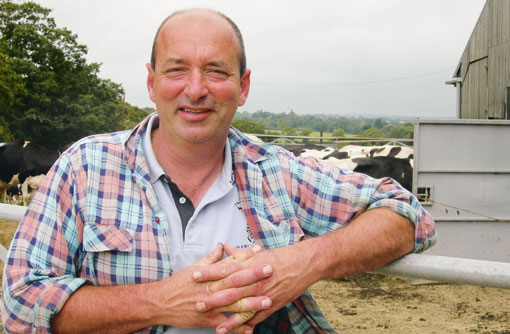
Six of Britain’s dairy herds have made it to the final of the NMR/RABDF Gold Cup 2012. Here’s how they look ahead of the announcement of the winner at Livestock 2012
Sussex herd – third time lucky?
Tim and Marion Gue are no strangers to the final stages of the NMR/RABDF Gold Cup – they’ve been here twice before. The Huddlestone pedigree herd, from Steyning in West Sussex, has increased in size since 2011 from 385 to 400 cows and is managed by the couple with help from four full-time staff, including two herd managers.
The herd calves from August through to April and is fed a total mixed ration all year round. Average production stands at 11,058kg of milk – around 250kg a cow more than in 2011 – at 3.82% butterfat and 3.12% protein on three-times-a-day milking. Average cell count for the year ending September 2011 was 117,000 cells/ml with a herd PLI of 77 – one of the highest among this year’s Gold Cup finalists. Milk is sold to Tesco via Arla.
“We’re not chasing yields, despite the increase and the high figures,” explains Mr Gue. “And we’ve altered our breeding policy from chasing index to focus more on better fertility and longevity alongside sound conformation and production.”
The herd’s predicted calving interval has also fallen by seven days to 400 during the past 12 months.
Recent investments include building a house on the farm for one of the dairy managers and a new cow house, which has space for 120 cubicles.
Cumbrian dairy makes gold cup final
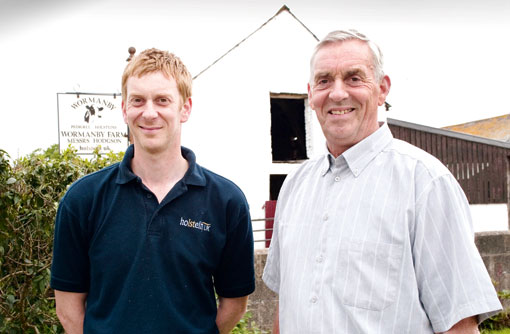
David Hodgson (right) pictured with his son Harry (left).
A commitment to dairying has helped take David and Louise Hodgson and their team into the final round of this year’s NMR/RABDF Gold Cup.
The 145-cow Wormanby Holstein herd, based at Burgh by Sands in Cumbria, is bred for longevity. This means that, as well as milk sales from their 145 milkers, the Hodgsons have up to 40 newly calved heifers for sale annually along with breeding bulls, amounting to a third of the business’ gross income.
For the qualifying Gold Cup year ending September 2011 the herd averaged 10,761kg of milk at 3.76% fat and 3.12% protein on twice-a-day milking.
“We believe that if you are breeding the right type of cows and you feed them correctly, the milk will follow. The aim is for cows to achieve 50,000kg within five lactations. Currently there are 40 Ex cows in the herd with 70 VG and 30 GP cows,” says Mr Hodgson.
Milk is sold to Arla on a liquid contract and while milk price is likely to have some influence on profitability, margin over purchased feed during the 12 months to March 2012 has increased by 15% to £2,120 a cow. The current cell count is 128,000cells/ml with a bactoscan of 23.
With a great deal of care and attention given to genetics, the Hodgsons know that their feeding management must support these high performance cows. They use a 60:40 grass silage and maize silage with 4.5kg of home-grown rolled barley and 5.5kg of a soya blend fed through a TMR wagon and pushed up three to four times a day.
Evesham dairy in running for Gold
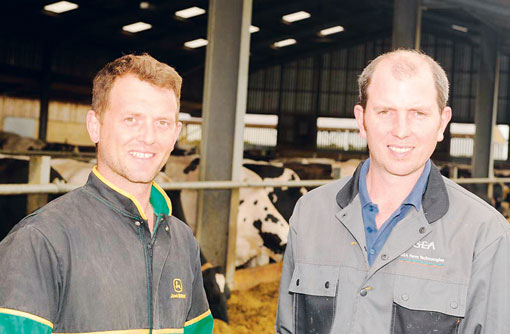
Steven and Paul Miller.
For the second year running the Miller family from Evesham, Worcestershire, has reached the final six in the NMR/RABDF Gold Cup. Mike and Shan Miller and sons Paul and Steven run the 320-cow Shanael herd on the 336ha tenanted unit.
During the past 12 months they have increased herd size and taken on more land. And they have also stepped up fertility and health management.
“We have facilities for 350 cows in the milking herd and by the end of the year we should hopefully be fully stocked. It makes sense to maximise the use of our buildings and parlour,” says Paul.
Impatient to increase cow numbers, the Millers are in the process of purchasing animals from quality pedigree herds.
NMR annual average production for the Gold Cup qualifying year ending September 2011 is 12,199kg of milk, 535kg higher than the previous year, at 3.6% fat and 3.08% protein on three-times-a-day milking.
Paul is pleased to see an improvement in calving interval to the current 410 days.
“We’ve made a real effort to improve fertility with more aggressive heat detection and routine vet visits increased to every two weeks, monitoring individual cows and trends through InterHerd.”
Milk is sold to Cotteswold Dairy in Tewkesbury under a liquid contract.
Ayrshire herd in final half dozen
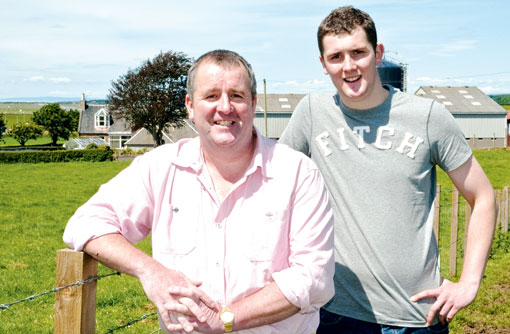
Gilmour Lawrie and his son Kevin.
In just 12 years Gilmour Lawrie has established a high genetic blended pedigree Ayrshire herd and is now making further investments for the future at Sandyford Farm, in Monkton, Ayr.
Mr Lawrie took on the farm just after the 2001 foot-and-mouth epidemic. Today half the 240 Brieryside cows are red-and-white with the remainder pure Ayrshire. Now farming with his son, Kevin, and in partnership with brother Jim, there are plans to increase numbers to 300 cows along with forage and cereal cropping of the 445ha.
To accommodate this expansion the cow housing is being extended with a new building providing 50 more cubicles and housing a new rapid-exit milking parlour with heat detectors and other management aids to help improve herd fertility. “Our current calving index is 418 days and we’re aiming for 400 days,” says Mr Lawrie.
Fundamental to the herd’s breeding policy is retaining the attributes of the Ayrshire, with milk quality and longevity being vital characteristics.
Of the herd, 52% have had four or more lactations with a number reaching nine lactations. While more heifers will be retained to increase cow numbers, some surplus heifers have been sold recently.
“Longevity is what I want. I don’t want to burn out the cows. If they leave the herd after two lactations they are not making any money,” he adds.
The herd’s average for the Gold Cup qualifying year ending September 2011 was 9,359kg of milk at 4% fat and 3.37% protein on three-times-a-day milking. Cell count averaged 121,000cells/ml.
Milk is sold at a premium to First Milk in Girvan on a Nestlé contract, which goes to make chocolate crumb to coat KitKat biscuits. Margin over concentrate a cow is £1,920 and Mr Lawrie hopes to increase that to more than £2,000 a head with improvements brought about with the new parlour.
Somerset herd makes last six
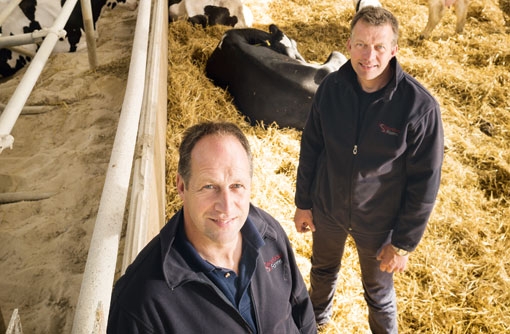
Neil and Michael Christensen
NMR/RABDF Gold Cup finalist 2012 Neil Christensen milks 517 Holstein cows at Steanbow Farms, Somerset, where he farms in partnership with his father Finn and his brother, Michael.
With 200ha of pasture taken up by the famous Glastonbury Festival each summer, the family made a drastic change to the farm strategy about five years ago – and haven’t looked back. They opted to house the cows all year round and changed the dry cow ration to combat high potassium levels in the grass.
The cows are split in to five groups, with the dry cows now fed on maize silage and straw. “If we feed just 2kg of grass we get problems with milk fever and cystic ovaries,” says Mt Christensen. “The soil indices would be great for arable land, but they are very challenging for the dairy.
“Looking back, given the current performance and profitability, it was certainly the right decision,” he adds. “The cows and staff are much more settled. We’ve spent a lot of money on a slurry store and calving buildings, but the unit is working really well now. Our focus from here will be on getting more milk from forage and just driving more efficiency by doing everything a little bit better.”
Production in the qualifying year to September 2011 for the herd averaged 10,521kg of milk at 3.78% fat and 3.13% protein on three-times-a-day milking. Cell counts averaged 104,000cells/ml.
Cornish herd goes for Gold
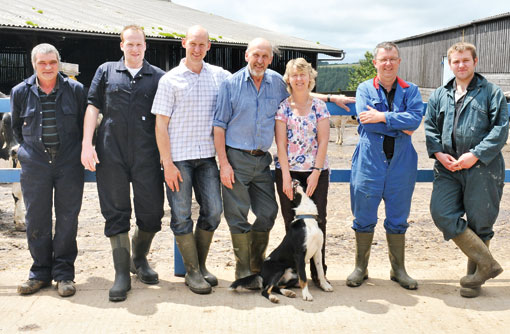
The Tredinnick Farms team.
NMR/RABDF Gold Cup finalist 2012 Matthew Rowe milks 360 cows in partnership with his parents at Tredinnick Farms, near Liskeard, Cornwall, and is confident of a bright future in the industry.
The Holstein herd averages between 3.2 and four lactations. In the Gold Cup qualifying year, ending September 2011, they averaged 8,956kg of milk at 4.13% fat and 3.22% protein on twice-a-day milking with a cell count of 189,000cells/ml and Bactoscan of 30.
The 228ha farm adjoins Bodmin Moor, making pasture management somewhat challenging. “We paddock graze and are getting about 2,500 litres from forage, but there is scope to increase that further,” says Mr Rowe.
The cows calve all year round, and were recently separated into new groups, comprising dry cows, heifers and older cows. “It’s made a huge difference – the heifers are a pleasure to be around,” he adds. “Because they’re not being bullied by the older cows they are a lot more content, they’re milking better and their feet are better. We really want to look after them because they are the future of the herd.”
The six NMR/RABDF Gold Cup finalists will be judged by David Cotton, chairman, RABDF; Bryan Thomas, ex-director, NMR; and 2009 Gold Cup winner Geoff Spence.
The winner will be announced at Livestock 2012 Incorporating Dairy Event at The NEC, Birmingham on Tuesday 4 September 2012 on the NMR stand (BM-194).
Livestock 2012
For more news, videos and a list of product on show at Livestock 2012 see our dedicated page.
